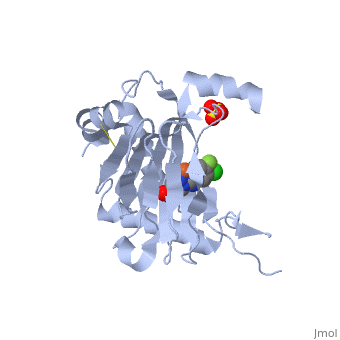3ouh: Difference between revisions
m Protected "3ouh" [edit=sysop:move=sysop] |
No edit summary |
||
| (7 intermediate revisions by the same user not shown) | |||
| Line 1: | Line 1: | ||
< | ==PHD2-R127 with JNJ41536014== | ||
<StructureSection load='3ouh' size='340' side='right'caption='[[3ouh]], [[Resolution|resolution]] 2.51Å' scene=''> | |||
== Structural highlights == | |||
<table><tr><td colspan='2'>[[3ouh]] is a 1 chain structure with sequence from [https://en.wikipedia.org/wiki/Homo_sapiens Homo sapiens]. Full crystallographic information is available from [http://oca.weizmann.ac.il/oca-bin/ocashort?id=3OUH OCA]. For a <b>guided tour on the structure components</b> use [https://proteopedia.org/fgij/fg.htm?mol=3OUH FirstGlance]. <br> | |||
</td></tr><tr id='method'><td class="sblockLbl"><b>[[Empirical_models|Method:]]</b></td><td class="sblockDat" id="methodDat">X-ray diffraction, [[Resolution|Resolution]] 2.51Å</td></tr> | |||
- | <tr id='ligand'><td class="sblockLbl"><b>[[Ligand|Ligands:]]</b></td><td class="sblockDat" id="ligandDat"><scene name='pdbligand=014:1-(5-CHLORO-6-FLUORO-1H-BENZIMIDAZOL-2-YL)-1H-PYRAZOLE-4-CARBOXYLIC+ACID'>014</scene>, <scene name='pdbligand=FE2:FE+(II)+ION'>FE2</scene>, <scene name='pdbligand=SO4:SULFATE+ION'>SO4</scene></td></tr> | ||
<tr id='resources'><td class="sblockLbl"><b>Resources:</b></td><td class="sblockDat"><span class='plainlinks'>[https://proteopedia.org/fgij/fg.htm?mol=3ouh FirstGlance], [http://oca.weizmann.ac.il/oca-bin/ocaids?id=3ouh OCA], [https://pdbe.org/3ouh PDBe], [https://www.rcsb.org/pdb/explore.do?structureId=3ouh RCSB], [https://www.ebi.ac.uk/pdbsum/3ouh PDBsum], [https://prosat.h-its.org/prosat/prosatexe?pdbcode=3ouh ProSAT]</span></td></tr> | |||
</table> | |||
<div style="background-color:#fffaf0;"> | |||
== Publication Abstract from PubMed == | |||
HIF prolyl 4-hydroxylases (PHD) are a family of enzymes that mediate key physiological responses to hypoxia by modulating the levels of hypoxia inducible factor 1-alpha (HIF1alpha). Certain benzimidazole-2-pyrazole carboxylates were discovered to be PHD2 inhibitors using ligand- and structure-based methods and found to be potent, orally efficacious stimulators of erythropoietin secretion in vivo. | |||
Benzimidazole-2-pyrazole HIF Prolyl 4-Hydroxylase Inhibitors as Oral Erythropoietin Secretagogues.,Rosen MD, Venkatesan H, Peltier HM, Bembenek SD, Kanelakis KC, Zhao LX, Leonard BE, Hocutt FM, Wu X, Palomino HL, Brondstetter TI, Haugh PV, Cagnon L, Yan W, Liotta LA, Young A, Mirzadegan T, Shankley NP, Barrett TD, Rabinowitz MH ACS Med Chem Lett. 2010 Oct 5;1(9):526-9. doi: 10.1021/ml100198y. eCollection, 2010 Dec 9. PMID:24900242<ref>PMID:24900242</ref> | |||
From MEDLINE®/PubMed®, a database of the U.S. National Library of Medicine.<br> | |||
</div> | |||
<div class="pdbe-citations 3ouh" style="background-color:#fffaf0;"></div> | |||
==See Also== | ==See Also== | ||
*[[ | *[[Polyl hydroxylase domain 3D structures|Polyl hydroxylase domain 3D structures]] | ||
*[[Prolyl hydroxylase domain|Prolyl hydroxylase domain]] | *[[Prolyl hydroxylase domain|Prolyl hydroxylase domain]] | ||
== References == | |||
<references/> | |||
__TOC__ | |||
</StructureSection> | |||
[[Category: Homo sapiens]] | [[Category: Homo sapiens]] | ||
[[Category: | [[Category: Large Structures]] | ||
[[Category: | [[Category: Clark R]] | ||
[[Category: | [[Category: Kim H]] | ||
Latest revision as of 05:14, 21 November 2024
PHD2-R127 with JNJ41536014PHD2-R127 with JNJ41536014
Structural highlights
Publication Abstract from PubMedHIF prolyl 4-hydroxylases (PHD) are a family of enzymes that mediate key physiological responses to hypoxia by modulating the levels of hypoxia inducible factor 1-alpha (HIF1alpha). Certain benzimidazole-2-pyrazole carboxylates were discovered to be PHD2 inhibitors using ligand- and structure-based methods and found to be potent, orally efficacious stimulators of erythropoietin secretion in vivo. Benzimidazole-2-pyrazole HIF Prolyl 4-Hydroxylase Inhibitors as Oral Erythropoietin Secretagogues.,Rosen MD, Venkatesan H, Peltier HM, Bembenek SD, Kanelakis KC, Zhao LX, Leonard BE, Hocutt FM, Wu X, Palomino HL, Brondstetter TI, Haugh PV, Cagnon L, Yan W, Liotta LA, Young A, Mirzadegan T, Shankley NP, Barrett TD, Rabinowitz MH ACS Med Chem Lett. 2010 Oct 5;1(9):526-9. doi: 10.1021/ml100198y. eCollection, 2010 Dec 9. PMID:24900242[1] From MEDLINE®/PubMed®, a database of the U.S. National Library of Medicine. See AlsoReferences
|
| ||||||||||||||||||
